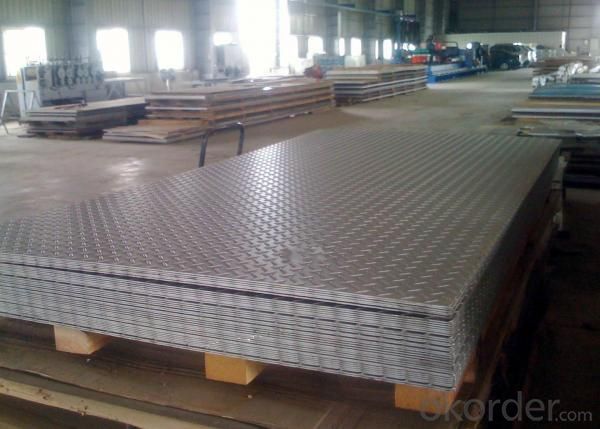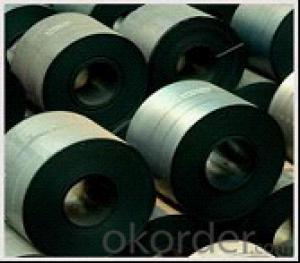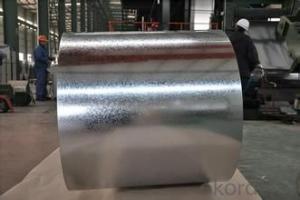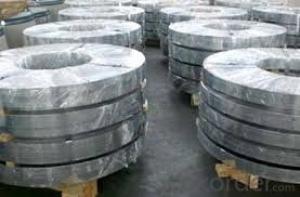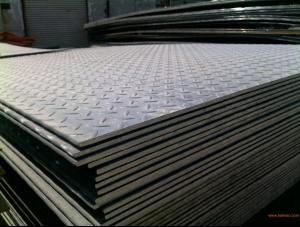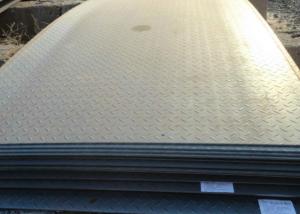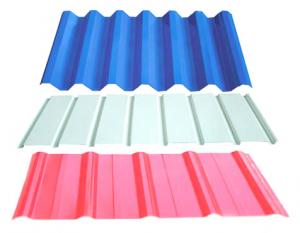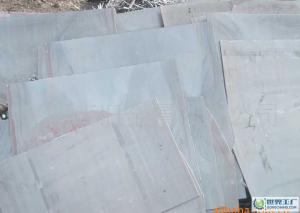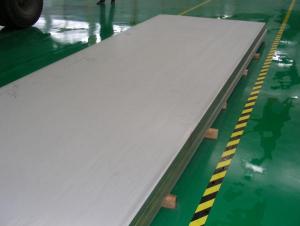High Quality Hot Rolled Checkered Sheet
- Loading Port:
- Xingang Port
- Payment Terms:
- TT or LC
- Min Order Qty:
- 100MT m.t.
- Supply Capability:
- 10000MT/Year m.t./month
OKorder Service Pledge
OKorder Financial Service
You Might Also Like
Specification of High Quality Hot Rolled Checkered Sheet:
1.Advantages of our High Quality Hot Rolled Checkered Sheet:
Our production capacity is extremly high, just as we take every details in producing and processing under strict control. For example, we have very high final rolling temperature, and meanwhile, the frizzling temperature must be kept suitable, so that the pattern cannot be made collapsed. That’s the reasons for our checkered sheet of high quality. The advantages of our checkered sheet could be read:
a) The unfairness of our checkered sheet: ≤10mm/mtr
b) The surface of our hot rolled checkered dimond plate is free from bubble, scab, crack, fold, edge delamination and so on.
c) The height of our hot rolled dimond plate will be maintained between 0.2~0.3 times to thickness of steel substrate, but more than 0.5mm at least.
2. Other details of High Quality Hot Rolled Checkereed Sheet(Q 345 C as example)
Standard | GB T 3277 |
Grade | Q345 C |
Thickness | 2.5-8.0mm |
Width | 1000-1600mm |
Length | 4000-8000mm |
Note: Dimension of our high quality hot rolled checkered sheet can be made according to your requirements, we can futher discuss about it.
3. The regular sections we provide are shown in the below table:
Base Thickness(MM) | Allowed Tolerance of Base Thickness(%) | Theoretical Mass (KG/M²) | ||
The Pattern | ||||
Rhombus | Beam | Pea | ||
2.5 | ±0.3 | 21.6 | 21.3 | 21.1 |
3.0 | ±0.3 | 25.6 | 24.4 | 24.3 |
3.5 | ±0.3 | 29.5 | 28.4 | 28.3 |
4.0 | ±0.4 | 33.4 | 32.4 | 32.3 |
4.5 | ±0.4 | 37.3 | 36.4 | 36.2 |
5.0 | 0.4~-0.5 | 42.3 | 40.5 | 40.2 |
5.5 | 0.4~-0.5 | 46.2 | 44.3 | 44.1 |
6.0 | 0.5~-0.6 | 50.1 | 48.4 | 48.1 |
7.0 | 0.6~-0.7 | 59.0 | 52.5 | 52.4 |
8.0 | 0.7~-0.8 | 66.8 | 56.4 | 56.2 |
4. Chemical Composition of High Quality Hot Rolled Checkered Sheet:
Grade | Chemical Composition | ||||
Q345C | C | Si | Mn | P | S |
≤0.20 | ≤0.55 | 1.00-1.60 | ≤0.035 | ≤0.035 | |
Note: Here, Q345C as example. We are also able to provide SGS test report for checkered sheet as per other material grade.
Applications of High Quality Hot Rolled Checkered Sheet:
1.Definition: The hot rolled checkered sheet with raised pattern on surface. The raised pattern could be shaped as rhombus,bean or pea. There is not only one kind of pattern on the checkered sheet, but also a complex of two or more than two kinds of pattern on surface of one checkered sheet. It also could be called as grid steel sheet.
2.Character: The Hot Rolled Checkered Sheet possesses a variet of advantages, such as beauty in appearance, skip resistance and saving steel material.Generally speaking,in order to test the mechanical property or the quality of hot rolled checkered sheet, the shaping rate and the pattern height should be tested primarily.
3. In conclusion, the hot rolled checkered sheet can usually be used in the industry of ship-building,boiler,automobil,tractor,train- building and architecture. In details, there are many demands for hot rolled checkered sheet to make floor,ladder at workshop,work frame pedal,ship deck,car floor and so on.
Package & Delivery of High Quality Hot Rolled Checkered Sheet:
1. The items to be prepared for packing include: narrow steel strip, crude steel belt or edge angle steel, kraft paper or galvanized sheet.
2. The high quality hot rolled checkered sheet should be wrapped with kraft paper or galvanized sheet ouside, and it should be bundled with narrow steel strip, three or two narrow steel strip in longitudinal direction,and the other three or two strips in transverse direction. Furthermore, in order to fix the hot rolled checkered steel plate and avoid the strip at edge shall be broken, the crude steel belt cut into square should be put under the narrow steel strip on the edge. Of course, the hot rolled checkered steel plate could be bundled without kraft paper or galvanized sheet. It depends on customer’s requirement.
3. In consideration of the transportaion from mill to loading port, the truck will be usually used. And the maximum quantity for each truck is 40mt.
4. All in all, we could do in accordance with customer's request.
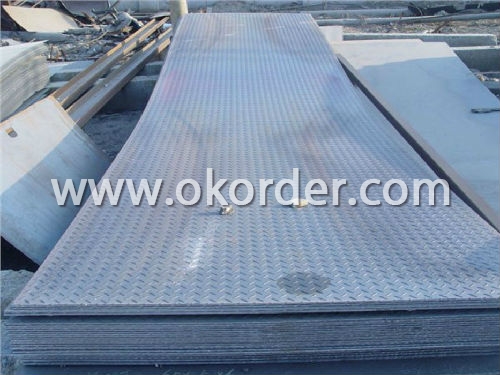
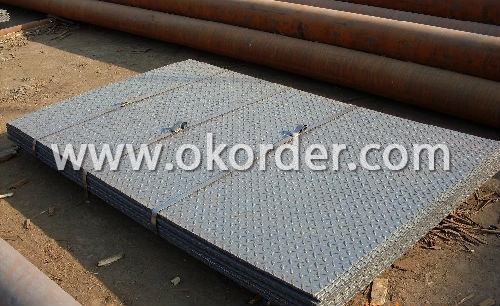
- Q: Can steel sheets be used for signage or displays?
- Yes, steel sheets can be used for signage or displays. They are durable, versatile, and can be easily shaped and customized to create various signage or display options. Additionally, steel sheets can withstand harsh weather conditions, making them suitable for both indoor and outdoor use.
- Q: What is the average wind load capacity of steel sheets?
- The average wind load capacity of steel sheets can vary depending on various factors such as the thickness of the sheet, the type of steel used, and the specific design and installation of the structure. However, steel sheets are known for their high strength and durability, making them capable of withstanding significant wind loads. Typically, steel sheets used for roofing or cladding applications are designed to meet specific wind load requirements based on regional building codes and standards. These standards take into account factors such as the geographical location, building height, exposure category, and wind speed. To determine the wind load capacity of steel sheets, engineers and architects use calculations and simulations to analyze the forces exerted by the wind on the structure. They consider factors such as wind pressure, building orientation, surface area, and the shape and profile of the steel sheets. In summary, the average wind load capacity of steel sheets cannot be generalized as it varies based on several factors. It is crucial to consult with a structural engineer or building professional to determine the appropriate wind load capacity requirements for a specific steel sheet application.
- Q: Are the steel sheets suitable for electrical applications?
- Indeed, steel sheets prove themselves to be fitting for electrical purposes. Being an excellent conductor of electricity, steel emerges as an optimal substance for a myriad of electrical components and applications. It finds utility in electrical enclosures, panels, cabinets, and other structures that accommodate electrical equipment. Moreover, steel sheets are frequently employed in grounding systems, electrical connectors, and electrical appliances. Furthermore, steel sheets offer sturdiness and safeguarding against environmental elements, including corrosion or fire, which hold paramount importance in electrical applications.
- Q: What is the process of laminating steel sheets?
- The process of laminating steel sheets involves several steps to create a composite material that is stronger and more durable than traditional steel. First, the steel sheets are cleaned and prepped to remove any impurities or contaminants. This is important to ensure a strong bond between the layers and prevent any defects in the final product. Next, a layer of adhesive is applied to one or both sides of the steel sheets. The adhesive can be a thermosetting resin or a thermoplastic material, depending on the desired properties of the laminated steel. After the adhesive is applied, the steel sheets are stacked together, with the adhesive layer(s) in between. The sheets are then subjected to high temperature and pressure to initiate the bonding process. This can be done using a hydraulic press or a hot rolling mill. The combination of heat and pressure causes the adhesive to melt and flow, creating a strong chemical bond between the steel sheets. The high pressure ensures that the adhesive is evenly distributed and fills any gaps or irregularities between the sheets. Once the bonding process is complete, the laminated steel sheets are cooled and trimmed to the desired size and shape. They can then be further processed, such as by cutting, bending, or welding, to meet specific application requirements. Overall, the process of laminating steel sheets involves cleaning and prepping the sheets, applying adhesive, stacking the sheets, subjecting them to high temperature and pressure, cooling, and finalizing the shape. This process results in a composite material with improved strength, corrosion resistance, and other desirable properties compared to traditional steel.
- Q: Are steel sheets resistant to graffiti?
- Yes, steel sheets are generally resistant to graffiti due to their smooth and non-porous surface, making it difficult for paint and other substances to adhere. Additionally, steel sheets can be coated with anti-graffiti coatings that further enhance their resistance to graffiti.
- Q: Are steel sheets suitable for harsh weather conditions?
- Steel sheets are highly suitable for harsh weather conditions due to their durability and strength. Steel is renowned for its ability to withstand extreme weather conditions, including high winds, heavy rain, snow, and hail. Moreover, steel sheets are designed to resist corrosion, rust, and degradation caused by prolonged exposure to severe weather, ensuring their longevity and dependability in any climate. Furthermore, steel sheets can be coated with protective finishes, such as galvanized or painted coatings, which further enhance their resistance to weathering. This aspect has made steel sheets a popular choice for various applications in areas prone to harsh weather, such as roofing, siding, and outdoor structures. They provide exceptional protection and structural integrity even in the most challenging weather conditions.
- Q: What are the different joining methods for steel sheets?
- There exist several methods for joining steel sheets, each with its own benefits and applications. 1. Welding, a widely used method, involves melting and fusing the sheet edges together with heat. Various welding techniques, such as arc, MIG, TIG, and spot welding, are available. Welding ensures robust and durable joints but demands skilled operators and can be time-consuming. 2. Bolting, another method, employs bolts or screws to connect steel sheets. This method is commonly preferred when disassembly or maintenance is necessary. Bolting guarantees strong and reliable joints, and it is relatively simple and quick. However, it may involve drilling holes and result in a less visually appealing appearance compared to welding. 3. Riveting, a method utilizing metal pins or rivets, effectively joins steel sheets. Rivets are inserted through pre-drilled holes and then deformed or expanded to secure them in place. Riveting ensures strong and secure joints, commonly used in applications requiring high shear strength. Nevertheless, it can be time-consuming and necessitates specialized tools and skills. 4. Adhesive bonding involves using specialized adhesives or bonding agents to join steel sheets. The adhesive is applied between the sheets and forms a strong bond as it cures. Adhesive bonding provides excellent aesthetics, leaving no visible joints, and evenly distributes stress across the joint. It finds common use in industries where welding or other methods are unsuitable, such as automotive and aerospace sectors. 5. Clinching utilizes mechanical force to join steel sheets. It entails deforming the sheet edges to interlock them and create a strong joint. Clinching is cost-effective as it does not require additional materials like fasteners or adhesives. However, it may not be suitable for applications requiring high load-bearing capacity. Ultimately, the choice of joining method for steel sheets depends on factors such as the application, desired strength, aesthetics, time constraints, and cost considerations. Each method possesses its own advantages and limitations, necessitating the selection of the most appropriate method for the specific project requirements.
- Q: What are the different types of steel sheet finishes for marine applications?
- There are several different types of steel sheet finishes that are commonly used for marine applications. These finishes are specifically designed to enhance the durability and corrosion resistance of steel sheets in marine environments, where they are constantly exposed to moisture, saltwater, and harsh weather conditions. 1. Hot-dip galvanized: This is one of the most common finishes for marine applications. The steel sheet is coated with a layer of zinc through a hot-dip process, which provides excellent corrosion protection. The zinc layer acts as a sacrificial barrier, preventing the underlying steel from rusting. 2. Stainless steel: Stainless steel sheets are highly resistant to corrosion and are commonly used in marine applications. The sheets are made from an alloy of steel, chromium, and nickel, which provides high strength and excellent corrosion resistance. Stainless steel sheets are available in different grades, with 316 stainless steel being the most commonly used in marine environments. 3. Powder coating: Powder coating is a popular finish for steel sheets used in marine applications. A layer of powdered polymer is electrostatically applied to the steel sheet and then cured under heat, creating a hard and durable coating. Powder coating provides good corrosion resistance and can be customized in various colors and textures. 4. Epoxy coating: Epoxy coatings are often applied to steel sheets in marine environments to provide superior protection against corrosion. These coatings are chemically resistant and provide excellent adhesion to the steel surface. Epoxy coatings are also known for their high impact and abrasion resistance. 5. Organic coating: Organic coatings, such as polyurethane or acrylic coatings, are used to protect steel sheets in marine applications. These coatings provide a protective barrier against corrosion and are commonly used in offshore structures, ships, and other marine equipment. It's important to note that the choice of steel sheet finish for marine applications depends on various factors, including the specific environmental conditions, budget, and desired aesthetics. Consulting with a professional or referring to industry standards and recommendations can help determine the most suitable finish for a particular marine application.
- Q: What is the difference between stainless steel and regular steel sheets?
- Stainless steel and regular steel sheets have distinct differences in their composition and properties. Stainless steel is an alloy comprising iron, chromium, and other elements like nickel and molybdenum. In contrast, regular steel is predominantly made of iron with small amounts of carbon and impurities. The primary disparity between stainless steel and regular steel sheets lies in their corrosion resistance. Due to the presence of chromium, stainless steel exhibits high resistance to corrosion. When exposed to oxygen, chromium forms a protective layer called a passive film on the surface of the steel, preventing rust formation. This makes stainless steel suitable for applications in environments with moisture or chemical exposure. On the other hand, regular steel sheets are susceptible to corrosion as they lack the protective chromium layer. To enhance their corrosion resistance, they may require additional coatings or treatments. Without proper protection, regular steel sheets can rust and deteriorate when exposed to moisture or corrosive substances. Strength and hardness are additional distinguishing factors between stainless steel and regular steel sheets. Stainless steel, with its alloy composition, is generally stronger and more durable than regular steel. It can withstand higher temperatures and has better resistance to wear and tear. Regular steel, while strong, may not offer the same level of strength and durability as stainless steel. Aesthetic appeal is another contrasting aspect. Stainless steel sheets have a shiny, reflective surface, imparting a modern and sleek appearance. They are commonly used in architectural and decorative applications where visual appeal is desired. Regular steel sheets, on the other hand, have a more dull and matte finish and are primarily utilized for structural and industrial purposes rather than for their visual appeal. In conclusion, stainless steel sheets surpass regular steel sheets in terms of corrosion resistance, strength, and aesthetic appeal. They are the preferred choice for applications where durability, hygiene, and maintenance-free performance are essential, such as in kitchens, medical equipment, automotive parts, and construction projects. Regular steel sheets, although less expensive, may require additional protective measures and are commonly employed in structural and industrial applications where corrosion resistance and visual appeal are not primary concerns.
- Q: Are steel sheets resistant to termites?
- No, steel sheets are not resistant to termites.
1. Manufacturer Overview
| Location | Tianjin, China |
| Year Established | 2004 |
| Annual Output Value | Above US$ 500 Million |
| Main Markets | China; Europe; America; Southeast Asia |
| Company Certifications | ISO9001、ISO14001、OHSAS18001 |
2. Manufacturer Certificates
| a) Certification Name | |
| Range | |
| Reference | |
| Validity Period |
3. Manufacturer Capability
| a) Trade Capacity | |
| Nearest Port | Tianjin; Qingdao; Dalian |
| Export Percentage | 41% - 50% |
| No.of Employees in Trade Department | 21-50 People |
| Language Spoken: | English; Chinese |
| b) Factory Information | |
| Factory Size: | Above 900,000 square meters |
| No. of Production Lines | 3 |
| Contract Manufacturing | OEM Service Offered |
| Product Price Range | High; Average |
Send your message to us
High Quality Hot Rolled Checkered Sheet
- Loading Port:
- Xingang Port
- Payment Terms:
- TT or LC
- Min Order Qty:
- 100MT m.t.
- Supply Capability:
- 10000MT/Year m.t./month
OKorder Service Pledge
OKorder Financial Service
Similar products
Hot products
Hot Searches
Related keywords





